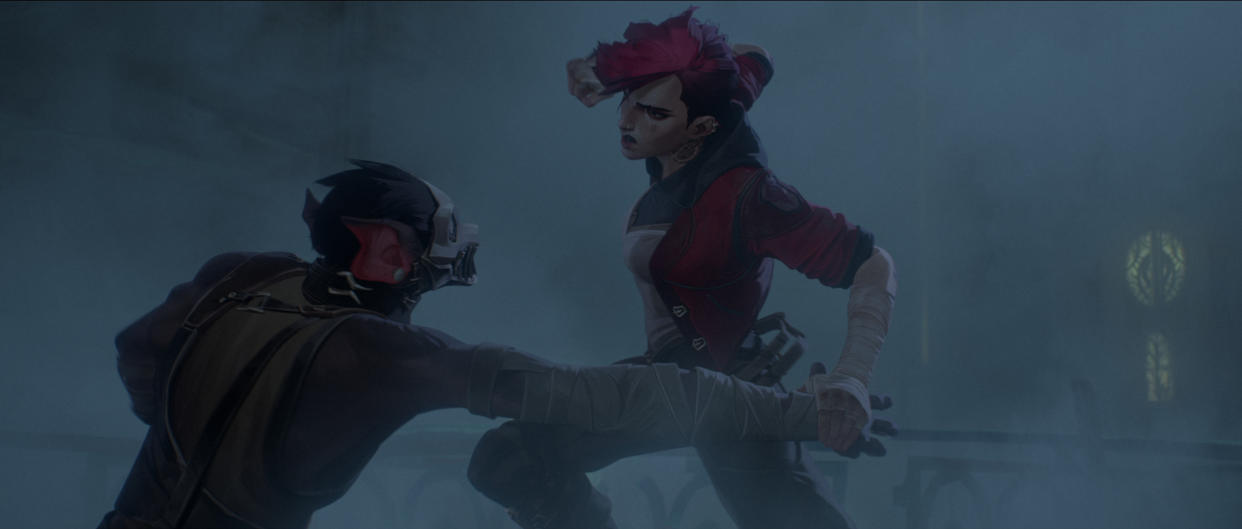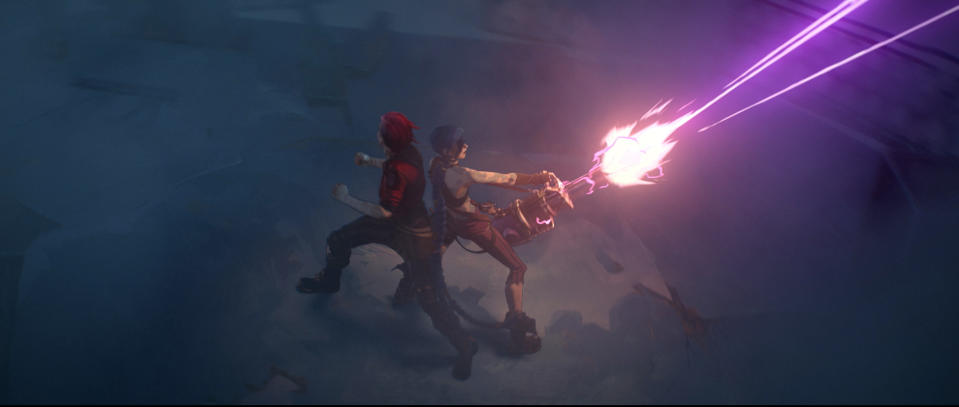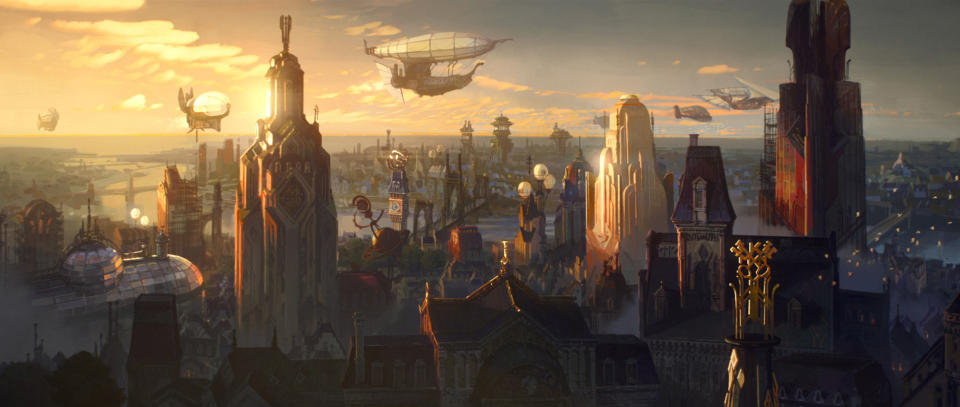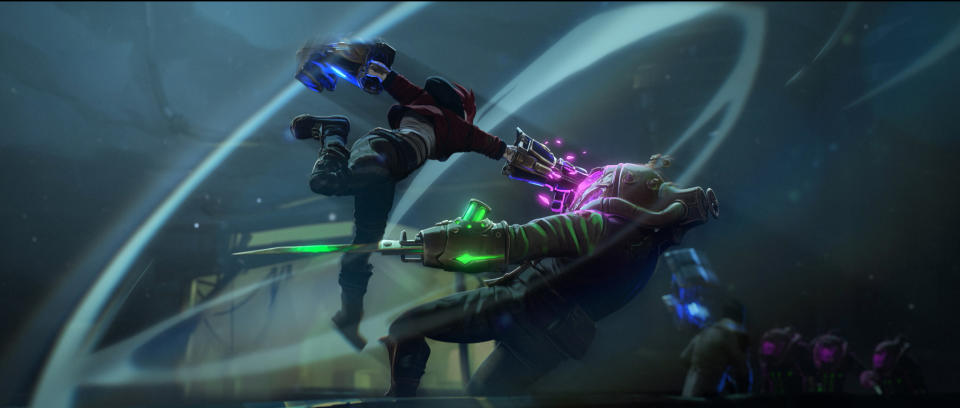How ‘Arcane’ Broke the Video Game Curse One Sound at a Time

- Oops!Something went wrong.Please try again later.
Based on Riot Games’ popular “League of Legends,” Netflix’s “Arcane” quickly became a hit show for Netflix. It knocked “Squid Game” off the most-watched charts for the streamer and received stellar reviews — a rare feat for a video game adaptation. “Arcane” not only swept the Annie Awards, but it’s now nominated for two Emmys: Outstanding Animated Program and Outstanding Sound Editing for a Comedy or Drama Series (Half-Hour) and Animation.
“We spent a lot of time trying to recreate the unique sounds of the game that stand out while playing, and ended up discovering that we could just use those iconic sounds as is and they worked,” Eliot Connors, co-supervising sound editor, told IndieWire. “But overall we tried to get as many original sounds as possible when building the sound library for the show, while picking from the library at Riot which they’ve amassed for a long time.
More from IndieWire
The Case for Disney as New Streaming King -- and the Case Netflix Never Lost Its Crown
Emmys 2022: Cinematography Nominees on How They Shot the Year's Best Shows
The key to “Arcane” is that it isn’t a direct adaptation of the game, but rather a loose prequel. The show focuses on the rivalry between sisters Jinx (Ella Purnell) and Vi (Hailee Steinfeld), two fan-favorite characters from the “League of Legends” who are caught up in a war between the prosperous and technologically advanced city of Piltover and the oppressed underground of Zaun, all while the discovery of magic — here referred to as Hextech — promises to change everything. The show is beautifully animated by French studio Fortiche, which has a long working relationship with video game studio Riot. (Following the release of “Arcane,” Riot fortified that relationship by making a significant investment in Fortiche.)
Riot oversaw every aspect of “Arcane”’s production, a rarity when it comes to video game adaptations — one that gave the sound designers a unique opportunity. “We came onto the project pretty early on after it got greenlit to just take the time to play and explore,” co-supervising sound editor Brad Beaumont told IndieWire. Beaumont, who works full-time at Riot with Connors, said the team came up with the sound of “Arcane” while the show was still in the animatic and storyboarding phase. “We were a big part of the creative process and actually had a seat at the table to make calls or suggestions on what may or may not be good for the story, even just on storyboards.”

Because of how long it takes to produce animation, this also allowed “Arcane” to be a rare show where the sound impacted the images on screen and not just vice-versa. “A lot of the artists could take the sounds that we designed and storyboarded around them,” added Connors.
“Arcane” stood out from most TV animated shows because of the way it used lighting, camera movement and cinematography techniques from live-action and applied them to animation. The result is absolutely stunning, and that live-action influence also applied to the sound of the show, with Beaumont and Connors looking at the production tracks of live-action shows and movies for inspiration. “We were looking for something that was really enveloping and immersive,” Connors explained. “So really rich and lush backgrounds and landscapes and especially the foley component was big on our list of things that helped sell the realism for the show. Things you oftentimes don’t see the time put in when it comes to animation and luckily we were afforded the luxury of time to do it.”
This last part is especially noticeable in the Emmy nominated episode “When These Walls Come Tumbling Down,” which serves as a sort of climax to the show, with Vi and Jinx reuniting after years apart and immediately engaging in a brutal fight against the gang known as The Firelights, all while new discoveries are made with Hextech. Though the end of the episode includes a bombastic and almost operatic fight scene, the first half is surprisingly serene and quiet, with a strong focus on foley sounds and minimalist music.
This was important for Connors and Beaumont, who wanted to avoid a cacophony of effects and sounds and instead leave room for silence. “We wanted to allow the sound to breathe and leave room for music to do its thing too,” Beaumont said. “Even during the heavy action scenes it is all about making decisions and playing the right sound at the right time, even if it’s passing the baton to the music or to the dialogue.”

courtesy of Netflix
Additionally, they wanted the sounds of “Arcane,” even when the show dives more deeply into its sci-fi and fantasy elements, to feel organic and real. Beaumont described the show as not futuristic like “Star Trek” but more of an alternate universe, and his sound design as taking inspiration from Ben Burtt’s work on the original “Star Wars” and making the sounds grounded in reality.
“We tried to take the same approach because it really makes the show feel alive,” Beaumont said. “We really pride ourselves on trying to find organic sounds and natural voices and animals.” This applied even to the more fantastical parts of the show like Hextech and the Shimmer, two magic-infused pieces of technology with big repercussions to the story. “At their core, the two have a vocal-like component that is supposed to feel like it’s alive,” Beaumont added. “Hextech has a pure and clean kind of tonality and a voice that’s almost calling you to it, while Shimmer has a more visceral and raw tonality as it is more primal.”

At a time where many filmmakers focus on producing specifically for the big screen even if their projects will never screen in theaters, “Arcane,” knows its audience. The show may be nominated for an Emmy for its sound design, and features moments of both big and spectacular action and moments of meditative silence, but Beaumont and Connors made sure the show would sound as good on stereo headphones as it does on the best home theater sets.
“The show is made, number one, for the players,” Connors said. “And Riot has a presence in a lot of different areas of the world where people are playing the game or watching the show using headphones. So we spent a lot of time making designing explosions and punches and sounds that would translate on headphones, and I tried many different pairs both good and bad to make sure the experience was the same whether you have an amazing system at home or a pair of old headphones.”
Best of IndieWire
Emmy Predictions: Outstanding Television Movie — 'Chip 'N Dale: Rescue Rangers' Revamp Makes History
Sign up for Indiewire's Newsletter. For the latest news, follow us on Facebook, Twitter, and Instagram.

